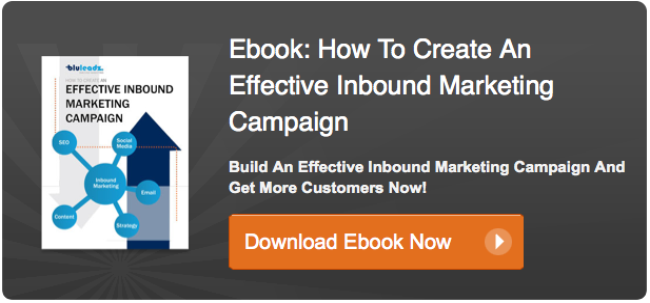Every good marketer knows that an inbound website is the hub for your core marketing efforts. And what's the main goal of an inbound marketing website?
To generate leads!
So whether you are considering a redesign of your current website or thinking about creating one for the first time, you'll need to start with a well thought-out gameplan that is focused on achieving your business goals.
If you don’t know where to start, then you're in luck! We're going to tell you how to design your website so it will generate a ton of leads that convert into customers and help grow your business.
First let’s cover some basics. At the very least you will need to make sure your website fulfills the following six criteria:
- It has a professionally designed look (whether you hired a designer or not)
- It’s on a Content Management System (CMS) so you you can make changes at will
- It includes an blog that is actively updated with fresh content
- It has some form of analytics tracking throughout the entire site
- The social media follow and share icons are integrated and easy to find
- It has a top navigation that is easy to understand and simple to use
Assuming that you have covered all of the basics above, we can move on to the real secret sauce and outline how to start generating those tons of leads you want.
In order to design that truly amazing lead capturing website, there are three things to keep in mind before the actual design work starts.
1. Identify Your Ideal Buyer Persona
The first step in designing a truly effective lead generating machine really doesn’t have to do with design elements at all. It’s all about understanding who your ideal buyer persona really is. Your business may cater to a few different buyers, but you probably have one that is your most profitable, loyal, and gives you the least headaches.
This is your ideal buyer persona and this is who you want to plan your design around. Yes, you will include content for everyone on your site but the goal is to attract more of these ideal buyers and less of the one’s you don’t want.
2. Uncover Problems and Questions
While you're getting closer to starting the design portion, you first need to figure out what the main problems (sometimes referred to as “pain points”) your ideal buyer persona experiences. Once you know what these are, find out what questions they are asking to find the solutions to their problems.
By identifying your buyer persona's problems and questions, you will be in a unique position to answer these questions and provide real solutions to their problems with content on your website, blog, and offers. Your site will be more than a destination--it will be a useful destination.
3. Map Persona Buying Process to Your Sales Process
We need to cover one last importance piece before your design really starts coming together. As of now, you should know what problems your buyer has, the questions they are asking, and now have a solution that helps them solve their problems.
Next you'll need to figure out how they buy. Typically you can find the answer to this question very easily. Just review the last 10 ideal customers and then figure out what steps they took along the way that led to them buying from you. This is your starting point, but you should take it one step further to see if there is room for improving their buying experience along the way. Some questions you should be asking are:
- Were there steps in their buying process that took place elsewhere that you could incorporate in your sales process?
- Are there other things you could be doing that your ideal buyer would find valuable and would make it easier for you to move them through the buying funnel? You need to put yourself into their shoes and identify exactly what their buying process SHOULD look like in a perfect world.
Design for Lead Generation
All that strategy now comes together with the tactics and tools of the design aspects. Outlined below are some of the important tactics you can use to create your lead generating website.
Offers
Offers like downloadable ebooks, guides, checklists, and videos are a great start to begin engaging your buyers. Here are some basic tips for creating remarkable offers that generate leads:
- Offers should be clear, concise and valuable to the lead that downloads it
- When placing offers on your website, ensure the primary offer for each page is large and prominent
- Each offer should align with the answer to one of your ideal buyer’s questions. For example, one question might be “How do I use inbound marketing to grow my business?” Create an ebook titled “How To Create An Effective Inbound Marketing Campaign” to help generate leads that are struggling to answer this question.
Smart CTAs
Calls-To-Action (CTA) graphics are used in conjunction with your offers to present them in strategic locations throughout your website and blog. What makes Smart CTAs “smart” is the fact that the buyer is only shown a call-to-action that they have not downloaded it already. By using smart CTAs in your website, you can guarantee that you are providing the buyer with the best user experience possible and continue to answer their questions with fresh, informative offers.
Smart Content
Similar in concept to smart CTAs, smart content is used to provide the buyer with personalized content based on their interests or stage in the buying cycle. This allows you to match your website content exactly with your buyer’s next stage in their own personal buying process, ensuring that you are providing them with the most relevant content.
Layout
The layout of your website is critical to your success at generating leads. The right layout will help you funnel your visitor’s attention to the areas that will help them the most. While every design should have common elements, there is no “one size fits all” layout. Here are few guidelines to keep in mind:
- Keep your message simple and to the point throughout the website
- Place CTAs strategically throughout your site
- Every page on your site should include a call-to-action
- Allow for enough “white space” so your offers stand out to the viewer
- Use social proof elements such as client list, a testimonial or recommendation
- Include graphics when appropriate. Nothing is more boring than endless pages of text on your website!
- It should be obvious to the buyer what the next step is in their buying process. You never want the buyer to be wondering what they should do next because they will probably leave your site
Landing Pages
Because landing pages are the last point of contact before a website visitor fills out a form to become a lead, it's important to make sure you're optimizing them correctly. Landing pages should follow the same design as the rest of your website (with a few key differences). Here are some things that you should keep in mind that will help you create top notch results and convert visitors into leads:
- Keep the layout of the landing page as simple as possible
- Get rid of the top navigation so you won't distract the viewer
- Use the shortest form possible to gather relevant info, preferably on the right of the page
- The form button should say something other than submit (Something like “Get Your Ebook Now!“ works well)
- Content on the right and keep it short and sweet, a few sentences and bullet points make it quick and easy to read.
- One awesome, relevant image, for visual appeal
I know it has been a lot to digest, but if you follow the guidance outlined above you will end up with a website that will truly generate loads of leads for you.
Eric Baum is the founder and CEO of BluLeadz, a HubSpot partner agency. Currently a silver level partner, BluLeadz offers website design and inbound marketing services. In addition to working with their own clients, BluLeadz also partners with other HubSpot agencies.
Originally published Oct 1, 2013 2:00:00 PM, updated January 18 2023
Topics:
Inbound MarketingDon't forget to share this post!
Related Articles

Expand Offer

